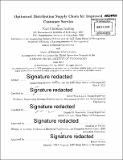| dc.contributor.advisor | David Simchi-Levi and Donald B. Rosenfield. | en_US |
| dc.contributor.author | Kulling, Karl Christian | en_US |
| dc.contributor.other | Leaders for Global Operations Program. | en_US |
| dc.date.accessioned | 2015-09-29T18:59:07Z | |
| dc.date.available | 2015-09-29T18:59:07Z | |
| dc.date.copyright | 2015 | en_US |
| dc.date.issued | 2015 | en_US |
| dc.identifier.uri | http://hdl.handle.net/1721.1/99029 | |
| dc.description | Thesis: M.B.A., Massachusetts Institute of Technology, Sloan School of Management, 2015. In conjunction with the Leaders for Global Operations Program at MIT. | en_US |
| dc.description | Thesis: S.M., Massachusetts Institute of Technology, Engineering Systems Division, 2015. In conjunction with the Leaders for Global Operations Program at MIT. | en_US |
| dc.description | Cataloged from PDF version of thesis. | en_US |
| dc.description | Includes bibliographical references (pages 54-55). | en_US |
| dc.description.abstract | In an attempt to attract consumers, companies are offering an increasingly wide range of product varieties to cater to each consumers individual needs and desires. This behavior leads to fragmentation of demand that increases supply chain complexity and cost. At Company X, this behavior is also visible. There is a proliferation of product types and sizes as these are increasingly used for product differentiation by both the company and original equipment manufacturers that use its products. This, in turn, lowers demand per product and disaggregates it, resulting in higher variability. Some of Company Xs products that are affected by the changes in demand patterns, and consequently have relatively low demand, are also highly profitable. This relatively small, but increasingly important segment of the market is not well served by the existing supply chain that has been optimized for large, steady flows of products. Service levels for products with the new demand patterns are low, leading to customer dissatisfaction and lost sales. We hypothesize that Company X can improve its customer service, as measured by service level, fill rate, and on time delivery rate, for consumer products by adopting a segmented supply chain. The current supply chain is optimized for products that have a steady and large demand, but it undersupplies products with low or variable demand. A segmented supply chain would allow each segment of products to be served by a supply chain that is optimized to that segments demand characteristics. Traditional manufacturing would provide a low-unit-cost source of products, while a new, agile small-scale manufacturing source would provide a responsive source of products. | en_US |
| dc.description.statementofresponsibility | by Karl Christian Kulling. | en_US |
| dc.format.extent | 55 pages | en_US |
| dc.language.iso | eng | en_US |
| dc.publisher | Massachusetts Institute of Technology | en_US |
| dc.rights | M.I.T. theses are protected by copyright. They may be viewed from this source for any purpose, but reproduction or distribution in any format is prohibited without written permission. See provided URL for inquiries about permission. | en_US |
| dc.rights.uri | http://dspace.mit.edu/handle/1721.1/7582 | en_US |
| dc.subject | Sloan School of Management. | en_US |
| dc.subject | Engineering Systems Division. | en_US |
| dc.subject | Leaders for Global Operations Program. | en_US |
| dc.title | Optimized distribution supply chain for improved customer service | en_US |
| dc.type | Thesis | en_US |
| dc.description.degree | M.B.A. | en_US |
| dc.description.degree | S.M. | en_US |
| dc.contributor.department | Leaders for Global Operations Program at MIT | en_US |
| dc.contributor.department | Massachusetts Institute of Technology. Engineering Systems Division | |
| dc.contributor.department | Sloan School of Management | |
| dc.identifier.oclc | 921307130 | en_US |
